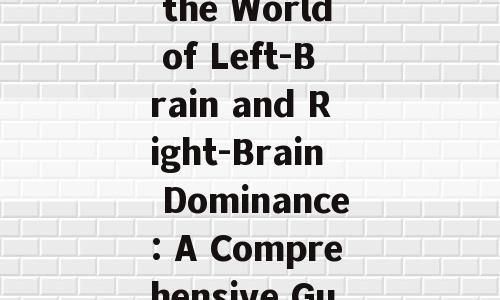Introduction
In the vast landscape of human cognitive abilities, the concepts of left-brain and right-brain dominance have intrigued many. This article delves into the origins of this theory, its relevance in the modern world, and practical applications for individuals seeking to understand and harness their brain's unique strengths. Whether you're a student, a professional, or simply curious about your cognitive profile, this guide will provide valuable insights into the fascinating world of left-brain and right-brain dominance.
The Left-Brain vs. Right-Brain Theory
The theory of left-brain and right-brain dominance suggests that different sides of the brain are responsible for various cognitive functions. While the concept is not without its critics, it remains a popular framework for understanding human behavior and abilities. The left brain is often associated with logical thinking, *** ytical skills, and language, while the right brain is connected with creativity, intuition, and visual spatial abilities.
Understanding Left-Brain Dominance
Individuals with a left-brain dominant cognitive style tend to excel in tasks that require structured thinking and detailed *** ysis. They are often precise, methodical, and detail-oriented. Left-brain dominant individuals are likely to be good at math, science, and languages. They tend to prefer structured environments and are often systematic in their approach to problem-solving.
Practical Applications for Left-Brain Dominant Individuals
For those who identify as left-brain dominant, there are several practical applications to consider. First, focusing on honing *** ytical and logical skills can lead to success in fields such as finance, engineering, and law. Additionally, developing a strong foundation in language and communication can be beneficial in any profession that requires clear and concise expression.
The Role of Right-Brain Dominance
On the other side of the cognitive spectrum, right-brain dominant individuals are characterized by their creativity, intuition, and visual spatial skills. They are often artistic, empathetic, and holistic in their thinking. Right-brain dominant individuals are likely to excel in careers that involve creativity, such as art, design, and music.
Practical Applications for Right-Brain Dominant Individuals
For those who lean towards right-brain dominance, nurturing creativity and emotional intelligence can be key to career and personal growth. Engaging in activities that stimulate artistic expression, such as painting, writing, or playing a musical instrument, can enhance cognitive flexibility and emotional well-being.
The Interplay Between Left-Brain and Right-Brain
It's important to note that while individuals may have a dominant cognitive style, both hemispheres of the brain work together to support various cognitive functions. This interplay is evident in activities such as problem-solving, decision-making, and emotional regulation.
The Science Behind Left-Brain and Right-Brain Dominance
Research on brain lateralization, the process by which different brain functions are localized to specific hemispheres, has provided insights into the left-brain and right-brain dominance theory. While the initial theories suggested a strict division of labor between the two hemispheres, more recent studies indicate that the brain's functions are more integrated than previously thought.
The Impact of Technology on Left-Brain and Right-Brain Skills
In the digital age, the demand for both left-brain and right-brain skills has evolved. While technology has automated many tasks requiring left-brain skills, it has also created new opportunities for right-brain skills, such as content creation, social media management, and innovation.
Conclusion
The concept of left-brain and right-brain dominance offers a useful framework for understanding individual cognitive profiles. By recognizing our unique strengths and weaknesses, we can make informed decisions about career paths, personal development, and lifestyle choices. Whether you are left-brain or right-brain dominant, embracing the full spectrum of your cognitive abilities can lead to a more fulfilling and successful life.
References
- *"The Left-Brain, Right-Brain Controversy: A Neurobiological Perspective" by Richard J. Haier, Ph.D., and Robert V. O. Cook-Deegan, Ph.D.
- *"The Whole-Brain Child: 12 Revolutionary Strategies to Nurture Your Child's Developing Mind" by Daniel J. Siegel, M.D., and Tina Payne Bryson, Ph.D.
- *"Brain lateralization: Past, present, and future" by Michael S. Gazzaniga, Ph.D., in *Annual Review of Psychology, 2011, 62:467-492.














还没有评论,来说两句吧...